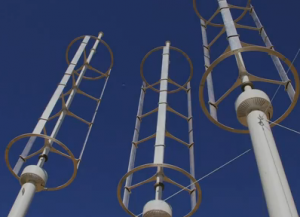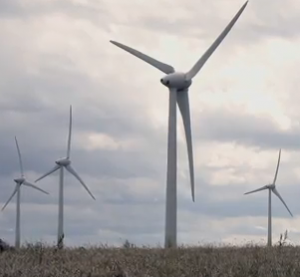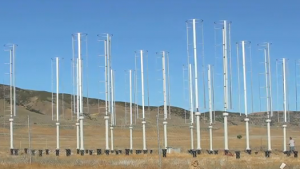Researchers at CalTech have found and verified (press release) an economical way to increase wind farm output at least 10x by optimizing turbine blade design and placement (stick with me, skeptics). They also found that the turbine blades can be placed much closer to the ground, significantly reducing cost and enhancing wind-farm profits. Watch the Caltech-produced video in the right hand window to follow the birth and testing of the new concept. T Boone Pickens, a new wind energy convert (who bears a startling resemblance to The Simpson's Mr. Burns), is already planning to moth ball and bulldoze his company's nuke plant and quickly replace it with idiot-proof and much safer (he still employs Homer) vertical axle wind turbines.

An experimental wind farm in California's hot and windy Antelope Valley
Inspired by the movement and flow of schooling fish and focusing on conventional wind turbine inefficiencies (which is like shooting fish in barrel), CalTech's team, led by John Dabiri, has been testing its theory at the Field Laboratory for Optimized Wind Energy (FLOWE), an experimental wind farm about 60 miles from Cal-Tech in California's windy and hot Antelope Valley, an alt-energy twofer. Ironically, this area is currently embroiled in a NIMBY donnybrook over a proposed large PV solar array, with many residents apparently opting for the tried-and-true local meth lab economy. The outcome's a no brainer: every dentist in town is firmly against the proposed clean-energy jobs. They can't afford to lose their current customers. How can I say that? I used to live there, and I can brag that I still have all of my teeth. John's turbine-work flows organically out of his research on jellyfish propulsion and fish-schooling, which won him a prestigious MacArthur fellowship at 30. Watch the following video to catch his research philosophy--and his sanguine appetite for risk: Despite the constant improvements in wind turbine design, which increases their efficiency, wind farms are still very inefficient, lagging the cost (minus externalities, but no one's directly paying for those anyway) of fossil fuels. This always effects financing, the bane of wind entrepreneurs in their unending struggle to find capital. Modern wind farms, usually employing horizontal-axis wind turbines (HAWTs)-- the standard propeller monoliths constantly morphing and lurching skyward, blades slowly turning in the same direction--contain design assumptions that John turns upside down. Just don't tell Siemens, whose latest mega turbines--taller and heavier than ever--now tower over the landscape like Michael Bey Transformers.

Turbine spacing is the most obvious achilles heel of traditional wind farms.
In such farms, the individual turbines have to be spaced far apart--not just so the giant, lumbering blades don't touch, but so that an their enormous wakes don't interfere with neighboring turbines--a little like airport wind shear. The result: "much of the wind energy that enters a wind farm is never tapped, slipping right by" says Dabiri. He compares modern farms to "sloppy eaters," wasting not just real estate (and increasing the cost) but much of the energy resources available to them. Or a sports metaphor might work: traditional HAWTs are like inept ice hockey goalies: everything slips past and scores right into the net. Compensating for energy loss with bigger and bigger blades and taller towers just escalates the built-in cost of the mistake. Dabiri asserts that with no one willing to admit the flaw, this just brings higher costs and more complex engineering problems. In short, bigger is not always better, and taller turbines, after all, also mean more noise and more danger to birds and bats.

The solution: examining the dynamics of fish-schooling
The solution is simply more holistic, says Dabiri, focusing instead on the design of the whole wind farm, to maximize its overall energy-collecting efficiency. Now we're back to the complex dynamics of fish schooling. And this design aslo works closer to the ground. Even though winds blow far less energetically at 30 feet than at 100 feet, that means, counter-intuitively, that more energy can be obtained with smaller, cheaper, turbines--as long as they're the right turbines, arranged in the right way. The bonus of VAWT placement, Dabiri says, is that they can be positioned very close to one another. This lets them capture nearly all of the energy of the blowing wind. Having every turbine turn in the opposite direction of its neighbors (another obvious fact learned by noticing fish-schooling turbulence), the researchers found that it also increases their efficiency, perhaps because the opposing spins decrease the drag on each turbine, allowing it to spin faster. In the summer 2010 field tests, Dabiri and his colleagues measured the rotational speed and power generated by each of the six turbines when placed in a number of different configurations. One turbine was kept in a fixed position for every configuration; the others were on portable footings that allowed them to be shifted around.

The new turbines significantly decrease land usage per turbine
The tests showed that an arrangement in which all of the turbines in an array were spaced four turbine diameters apart (roughly 5 meters, or approximately 16 feet) completely eliminated the aerodynamic interference between neighboring turbines. By comparison, removing the aerodynamic interference between propeller-style wind turbines would require spacing them about 20 diameters apart, which means a distance of more than one mile between the largest wind turbines now in use. The six VAWTs generated from 21 to 47 watts of power per square meter of land area; a comparably sized HAWT farm generates just 2 to 3 watts per square.


